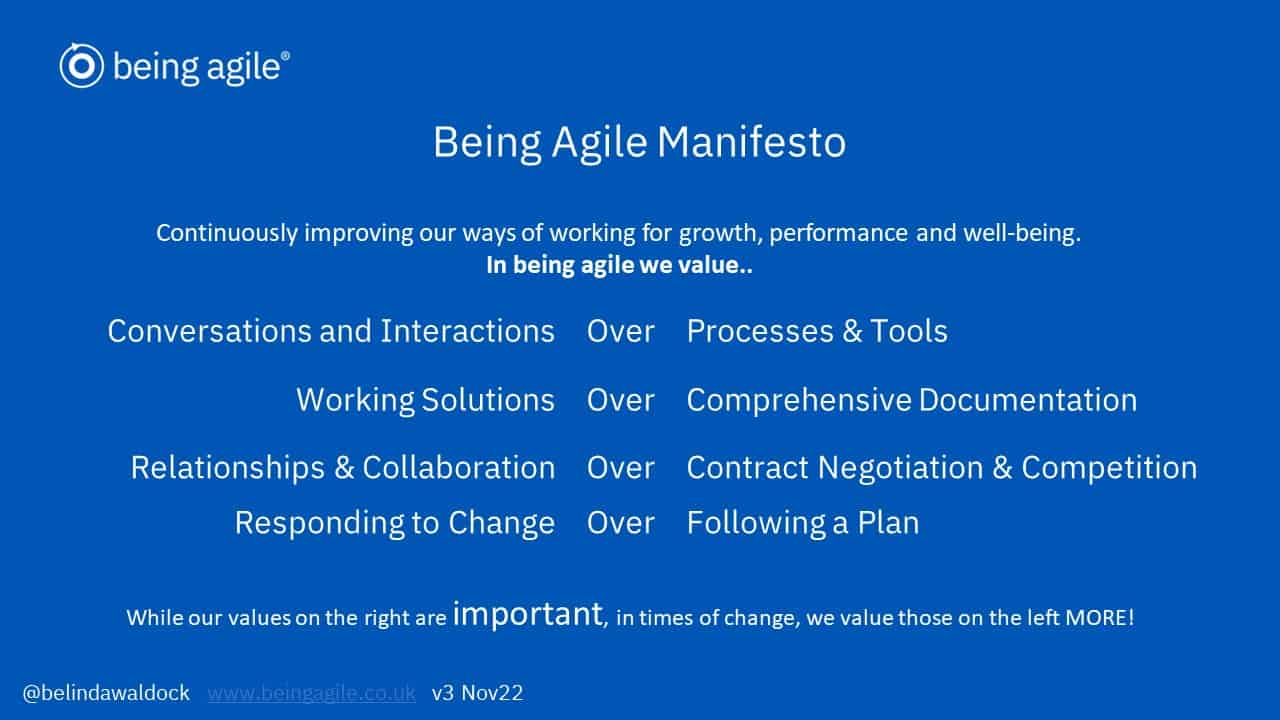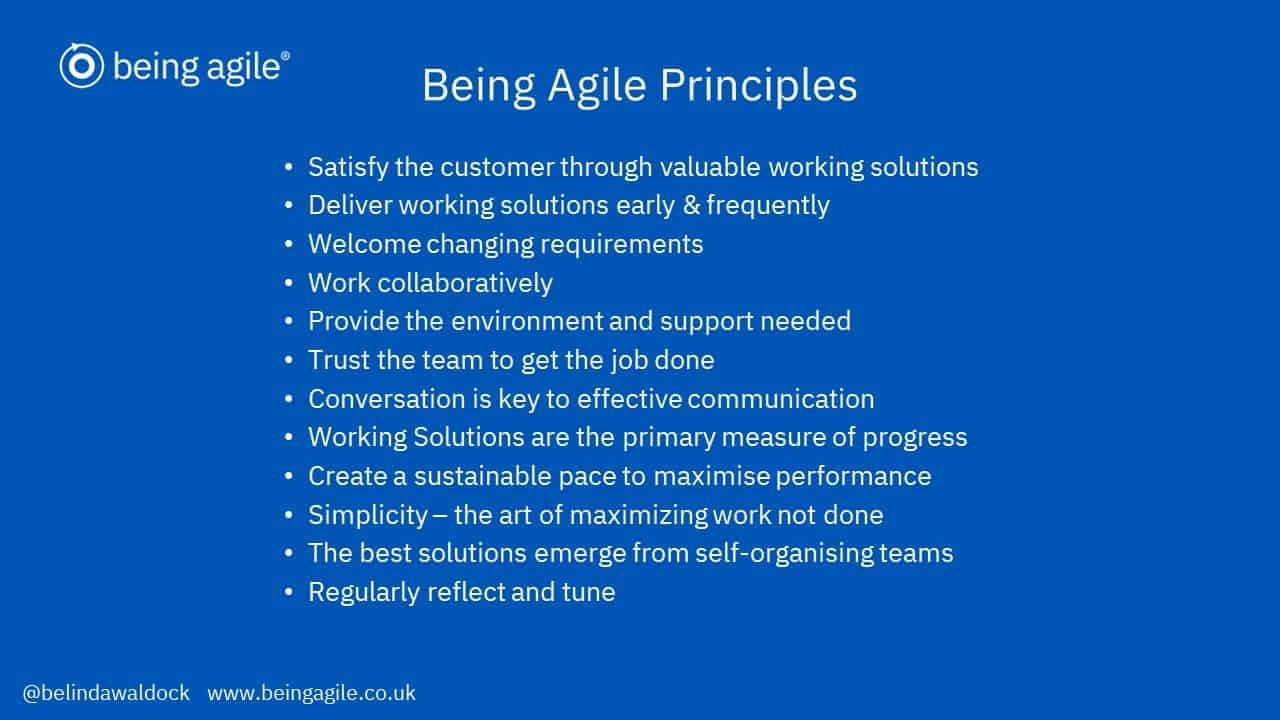Continuously improving our ways of working for growth, performance and well-being.
In being agile we value..
While our values on the right are important, we value those on the left MORE!


Being Agile Manifesto & Principles 2.0 (last Updated Sept 2022)
13:41:52 Hello, i’m Belinda, from being agile and this is a session on the being agile manifesto and principles.
13:42:00 Now, the agile manifesto and principles have a little bit of an update.
13:42:04 Just a small refinement, so I thought it’d be really good to have a new session on this, and just to include those extra little bits, but very very similar to the original being agile manifesto
13:42:15 now the original original software agile manifesto and principles are absolutely brilliant for its adoption and use in software
13:42:25 But being agile, very much works with businesses beyond technical adoption, adoption.
13:42:30 So the being agile manifesto has really been adapted for a broader adoption.
13:42:37 So not just about software, but also about solutions.
13:42:45 And about business agility as well as product and software.
13:43:28 And so the original agile manifesto was very much developed for the software sector, and in the last, gosh 20 years, it’s been refined and adopted for use more broadly.
13:43:44 As part of being agile and the being agile method, tool set and approaches have been adapted and evolved from those used in software development for broader use across business and outside of tech.
13:43:55 And the fact is this there is demand for agile, for agility within business, because what often we’re planning now in business, and what happens can be very different.
13:44:11 So we need to take a more agile approach. We need a more adaptive approach to our business methods and management models.
13:44:21 So. if we think about why we want to be agile, because things are changing and adopting a voice, what this means is that we can’t necessarily take the predictive approach that we would often take when we’re down in this bottom left hand corner of this matrix. say when we know exactly what we’re doing.
13:44:41 We’re close to agreement on what we’re doing and we’re close to certainly, on how we’re going to do things We can take fairly simple predictive approach and plan things out.
13:44:51 We can follow fix processes and tools, and we can do that work, and then we can evaluate it at the end.
13:44:56 But when we are more far from agreement and far from certainty about what we’re doing, and how we’re going to do things, then things become more complex and often more chaotic and of course, the tech sector spend a lot of their life up there in complex and chaotic, creating very complex and dynamic software.
13:45:15 But certainly very true of businesses and organizations.
13:45:18 Now is that we, too, are operating this complex, ambiguous, chaotic environment.
13:45:24 Whether there are unknowns we don’t know what we don’t know, and therefore, agile as a methodology helps us to navigate that and to move forward despite that change in interruption
13:45:38 Let’s have a look at the agile manifesto.
We need to keep that perspective. So we’re not down there in simple we don’t know what we’re doing, or how we’re going to do things.
13:45:52 So our traditional approaches might not work as well. So we need to take this slightly different attitude, Slightly different mindset and behaviour towards how we approach our projects and our business.
13:46:10 Great, the being agile, manifesto. So we are continuously improving our ways of working for growth, performance, and well-being, and in being agile, we value individuals and those interactions over our existing fixed processes and tools.
We value working solutions over comprehensive specification proposals, plans, documentation.
13:46:33 We value collaboration with our customers, partners, suppliers over those contract negotiations, and we respond to change over following our plan. So while we value the things on the right hand side, and they are certainly important.
13:46:50 We definitely need to have a plan. We need to have contracts in place.
13:46:53 We should have documentation and processes and tools to help.
13:46:59 To optimize make is more efficient and effective. But in times of change we need to value these things on the left. more.
13:47:04 We need to value these individuals and interactions, so we can understand the changes and the differences better.
13:47:10 That we can share working solutions early to get that feedback, so we can understand better what we need and how we’re going to need things because we cant big up front plan things.
13:47:23 We can’t create comprehensive documentation right at the start, because we don’t know what we don’t know yet.
13:47:28 So we need to start with that working solution
Collaboration over contract negotiation contracts absolutely, we should definitely have them.
13:47:36 I am not saying for one second we should not have contracts.
13:47:40 But if that relationship and that rapport with our customer with our partner, our supplier breaks down, then those contracts are really hard to sustain and maintain and become ineffective, and unviable, and we should certainly have a plan we should certainly have plan of what we’re going to.
13:48:00 What we want to do. but it might be a not be a fully detailed plan.
13:48:02 It might only be for the initial plan. But more importantly, we need to accept that.
13:48:10 That plan is our best guess of what’s gonna happen and actually as we start the as we saw our process that actually, we’re gonna understand more about that.
13:48:19 And therefore we can adapt and evolve and improve our plan.
13:48:22 So we want to be able to respond to change over following the initial.
13:48:26 So the manifesto really helps us to think about while they things on the right are important that actually we need to value these things on the left. more when things are unclear about what we’re going to be doing or how we’re going to achieve them.
So let’s have a look at the principles. This is drilling down into how do we actually, what do we need to do in order to live these values.
13:48:50 So again, these principles have been adapted from the original software manifesto and principles.
13:48:58 They’ve been adapted and simplified so they can be used more broadly.
13:49:02 But I hope still retain to retain that sentiment of agility.
13:49:06 So, with the being principles we want satisfy the customer with valuable working solutions, and we want to deliver those working solutions early and frequently.
We want to welcome those change in requirements, because, as we were just saying what we’re gonna learn, and understand, as we go through, the project, so
13:49:24 we can change things and make better. We want to work collaboratively with our customers, with our partners, with our suppliers.
13:49:32 We want to provide the environment and support needed to our teams and then trust them to get the job done.
13:49:41 That conversation is absolutely key to effective communications. It’s individuals and interactions over those processes and tools.
Working solutions are our primary measure of progress. So progress is measured by the fact that we actually have a working solution out there, rather than reports or measures that show our progress towards that working solution, we get out of that really quickly.
13:50:07 One really important thing is this creating a sustainable pace to maximize our performance. And so we need to look at how we can create this sustainable pace which allows our teams to work effectively without being stressed or over, pressured.
13:50:25 Continuous feedback, learning and improvement enhances our agility, in essence it’s never done.
13:50:32 You know we are constantly, we should be constantly adopting adapting evolving our methods, our tools. Our approaches to how we run our organization as it grows and changes.
Simplicity the art of maximizing work not done.
13:50:48 So this is around the Pareto Principle
13:50:51 So 80% of the value you get out of something comes from just 20% of the effort you put in.
13:50:56 So that minimum viable product where is that 20% of the effort that’s gonna gain you that 80% value.
13:51:03 And at the other end you know that law of diminishing returns.
13:51:06 So is this extra things that we’re doing are they actually adding value?
13:51:11 Or are they costing more than the value that there are creating.
The best solutions emerged from self-organizing.
13:51:19 Teams are going back to. If we give people the environment and the support, the resources and the skills that they need trust them to get the job done, allow them to self-organize self-manage.
13:51:29 They will create brilliant solutions.
And finally and very importantly, if there’s one thing you’re gonna take away from this list, I I definitely recommend what this one is to regularly reflect and retune So making
13:51:43 sure that throughout our processes that we are, and and throughout our product, development or project management, our team working, our organizational change, whatever it might be that we are regularly pausing and reflecting and retuning
13:52:02 So that we are catching things early, so that we are learning early, and we can build that in early.
13:52:07 And so that we can create a better value and better solution in the long term.
13:52:11 So that’s being agile methodology in principles I hope you find it really useful.
13:52:18 One for simplifying these these they’ve met that manifesto in principle that she’s within the software sector.
13:52:24 But also, if you’re looking at using agile in the software sector, these values and principles making a bit more sense to you in this broader form
so I hope you’ve enjoyed that if you’d like to find out
13:52:37 more than please do get in touch visit beingagile.co.uk and you can find courses and more videos and content.
13:52:46 And i’m always always looking forward to working with teams live and so really exploring your agile journeys and helping you with that, and supporting that there is an agile manifesto black shop and often I work with teams
13:53:01 to create their own style. they’re a brand of agile and they’re a mix of agile, and so one of these things is to create your own manifest day So there’s a workshop on that so if
13:53:12 you’re interested. Do drop me an email and we can chat more.